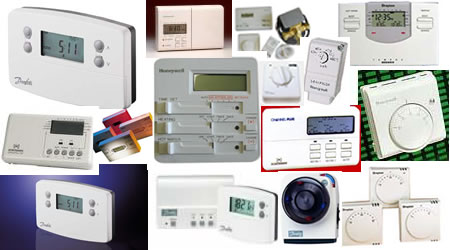Central Heating Controls
Or if you know what manufacturer or type of control you require, click on one of the following links to visit the appropriate page of our online catalogue: Click on the boiler manufacturers name below to visit the appropriate page of our online catalogue:
This is the most important part of any central heating system. A central heating system is only as good as its controls, the better the controls, the less wear and tear on the boiler and system. You will get more comfortable, controllable temperatures and in turn the running costs will be less.
Time Switch (clock)
A Time Switch (clock) will switch all the system on or off to the times you require
Cenrtral Heating Programmer
A Programmer will switch one, two or even three different circuits on or off at different times or even on different days. Most programmers have integral switches to set them up to your own personal preferences, for example, to have the hot water and heating to come on separately at a different time each day of the week. (Override buttons are also fitted to programmers) A programmer should be set to cover all the times that the property is occupied. A signal is sent out to the cylinder and room thermostats and these will keep everything at the desired temperatures.
Cylinder thermostat
If your system is warming a cylinder of water, you must have a Cylinder thermostat, this should be set to about 55-60 deg °C and should be positioned approximately 1/3 the height of the cylinder from the bottom. Once this is satisfied it allows the hot water circuit to rest, and boiler to rest if no other control is calling for heat, until some hot water is used or the cylinder cools down naturally.
Room Thermostat
All central heating systems should have a Room Thermostat fitted, this will shut the heating circuit off, allowing the boiler and system to rest once the air has reached the desired temperature. As the air starts to cool slightly, the room stat brings the heating on again to maintain the set temperature. This should be fitted about 1.5 metres high in an average temperature room with a radiator fitted, but not in direct sunlight or above a radiator, and have no other source of heat in that room. Usually these are best fitted in a hall or dining room. Since April 2002 it is mandatory as part of the Building Regulations that all new and updated systems have a room thermostat fitted.
Programmable Room Thermostat
A Programmable Room Thermostat is the same as a room thermostat, except you can program different temperatures for different times of the day and night, also there is no need for any other timing device on this circuit (also acts as a frost stat). Some Models have a 7 day option, so the temperatures and times can be set differently for each day. This is the only control needed for combination boilers.
Thermostatic Radiator Valves (TRV's)
Thermostatic Radiator Valves (TRV's) fit on radiators in place of existing valves. Inside the valve is a wax capsule which expands when heated and stops the flow of water to the radiator. As the wax cools it contracts and lets the water from the boiler flow into the radiator. A TRV should not be fitted in the same room as the room thermostat as this can interfere with its operation. When the room stat is satisfied it will shut the pump & boiler off (providing another circuit is not calling). For best economy just fit TRV's in rooms that are too warm (bedrooms) or in south facing rooms and unused rooms. If you have a condensing boiler then do not fit too many TRV's, usually no more than a third of all radiators, as they will reduce the high efficiency of the boiler.

